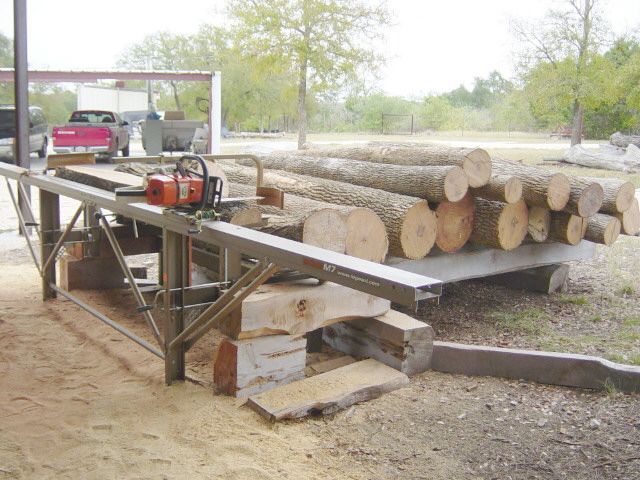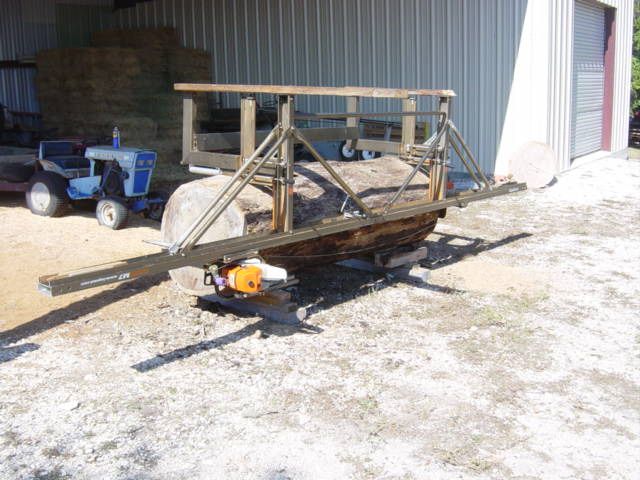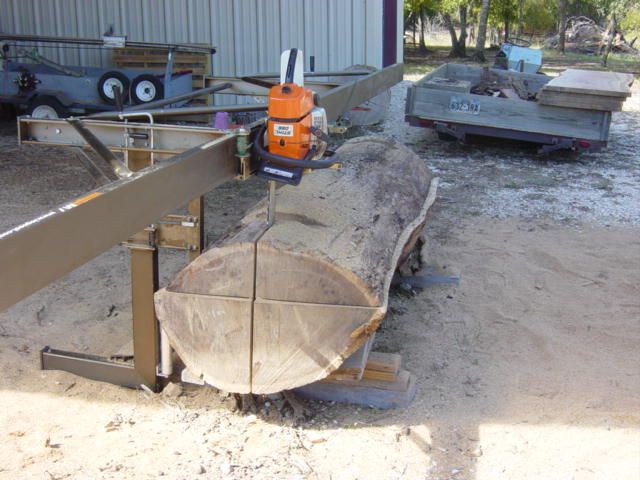Chainsaw-Driven Bandmills
Is a chainsaw motor a good choice for powering a bandsaw mill? September 10, 2007
Question
I think I once saw an ad for a bandmill head that was driven by a chainsaw engine. I have not been able to find it on the web. Does anyone know who might be selling this type of unit?
Forum Responses
(Sawing and Drying Forum)
From contributor D:
Maybe they aren't around anymore because they are not too practical. You can buy a 13 hp Honda for less money than a saw with enough whappa to run a mill. A Husqvarna 395XP chainsaw, for example, will set you back $900 and it has 7 hp, but you can get a 13 hp like I was talking about for $800.
Sure, the chainsaw already has the clutch built in (they are not cheap). But there are other factors like longevity and noise. My little Honda purrs like a kitten, and my Husky 395XP is loud. That 4 stroke Honda will outlast that 2 stroke motor without any doubt, especially sawmilling.
They make chain mill attachments for saws. I think for the right situations they satisfy the user. I just don't know about a bandmill run with a chainsaw motor.
From contributor T:
Amazon.com has them listed. $1600 for the sawmill (powerhead not included), then another $900 for a saw that will run it... I'd look around and see what else I could do for around that price before going that route.
From contributor L:
I have a Hudson 18" band mill with a 6.5 Briggs. It does alright, but it could use more power. I have 3400 into it and the first 10 blades, but it will outlast any chainsaw motor that I have ever had any dealings with. If you know of a chainsaw motor that will stand the abuse, it might be worth buying, but the motor runs wide open for longer durations sawing lumber than they were intended for as a chainsaw. There might be one that will take it, but I haven't found one yet. I do have a shop full of locked up chainsaws, though.
From the original questioner:
Thank you all for your advice! I think I'll take it and look for something else. Have a great day!
From contributor O:
The first mill I used was a BetterBuilt brand I think, a small bandsaw run by a big Husky or Stihl chainsaw head. Easily convinced me to buy a conventional bandsaw mill. It was all manual, and in turn, convinced me to buy the TimberKing B20. All hydraulic, and with my health problems I can still mill lumber. Those little chainsaw mills will kill your back. I am almost 50, recovering from brain surgery, so I need to think about such things. You don't ever think you are going to get sick.
From contributor B:
Here is my sawmill. The powerhead is a Stihl 066 - 7.5hp. I have a 16" bar on it in the picture and do about 90% of my board sawing with it. I also have a 20, 25, 36, 42, and 52" bar that I can use when needed. The mill is extremely accurate and versatile. Yes, this forum has those that will jump all over me for wasting wood in a 1/4" kerf. But remember, my 16" bar cuts a dead flat board as smooth or smoother than a bandmill and with no blade waving at knots, hard spots, etc. I have had bandsawn boards that, after jointing and planing the wave out, wasted more wood at the jointer/planer than my chainsaw, so the net results end up being about the same. I have been sawing with this powerhead since 10/2001 and have sawn over 10000bf. I have a tach and keep it in tune and clean. It is like cutting butter and is a joy to use.

Click here for higher quality, full size image
From contributor J:
I have been using a Stihl 066 with a Granberg mill and am considering getting a small bandmill. I use Bailey's ripping chain on 24 and 32 inch bars. What kind of chain have you been using? How large of a log have you put on your Logosol? I saw one at a show about 3 years ago and now you have me thinking about it again. I am a woodworker (60 years old) looking for a mill for my own use (not to sell lumber).
From contributor B:
Here I am sawing a 36" bur oak. The mill is rated to hold only 1100lbs so when you have an extra large log, just drag the mill to the log and invert it on top of the log, add a couple of screws to keep it in place, and the saw does not care that it is upside down. Without the saw on it, the mill weighs 115 lbs. A great advantage of this mill is that, when not cutting inverted, you cut at normal standup position and all you do is hold the throttle down with your left hand and turn a crank with your right hand.

Click here for higher quality, full size image
From contributor B:
I sliced four 2" flitches - on the trailer - then lifted the top off, removed the flitches and set the top back down. I then remounted the mill at 90 deg and quartered the log. Then I set the mill upright and quartersawed the quarters normal fashion. I used a 36" bar on this sawing and switched to my 16" bar to quartersaw the boards.

Click here for higher quality, full size image
From contributor T:
Contributor B, can you estimate how long it took you to saw up that bur oak, and how much lumber you got out of it?
From contributor B:
It takes about 5-8 minutes to take the full 36" swath down the 8' log. When I sawed up the quarters with my 16" bar, about 4 minutes or less per cut. Actual sawing time is not that long but it took the better part of a day to cut the whole thing - a lot of time is spent wrestling that big of a log into the right setup. Band mill hydraulics are much faster - but where is the fun?
How much wood? Not sure, but I got a lot of nice boards, plus those 4 2" flitches, or slabs, as some may call them. I guess we could calculate - 36" by 8', almost no taper. This log was 16' to 24' up the tree. The bottom was 48" + and hollow until about 12' - a big disappointment. I cut a 3' section of the hollow and set it up in the yard, filled it with dirt and the wife planted flowers in it - she was delighted.


